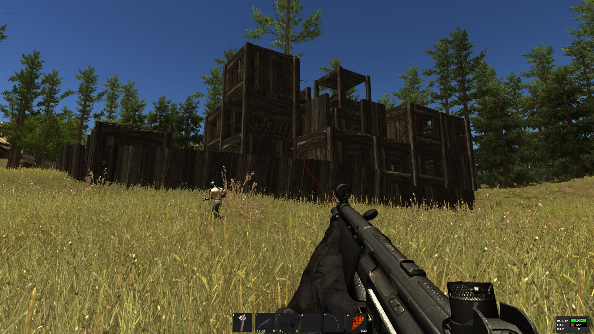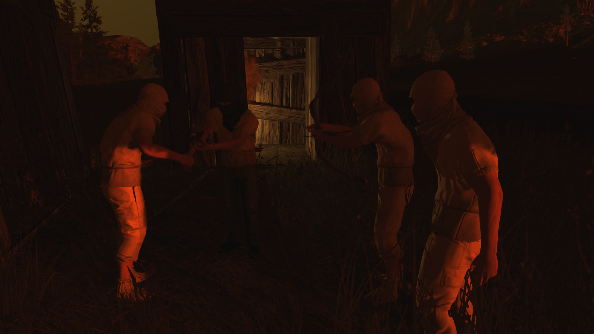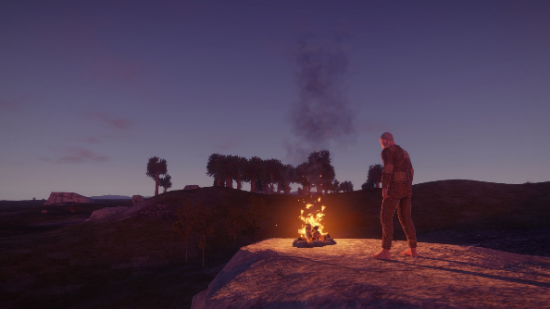Rust – Facepunch Studios’ multiplayer survival sandbox – has changed significantly in the year it’s been on Steam Early Access. After several months of incredible sales and gradually increasing content, Facepunch did the unthinkable: they scrapped everything. Deciding the code base for Rust was unworkable, the studio rebuilt the entire game from scratch in a new engine. New Rust looks and feels both different and familiar: like returning to your dreary university city after it’s had a multi-million government investment.
I don’t like it.
Rust’s head developer Garry Newman doesn’t like it either. In his end-of-year developer blog, he graded Rust’s progress at C-. They called that ‘significant room for improvement’ when I was at school, and it certainly applies here. “The game looks better than it ever has, but what we gained in graphics we have lost in gameplay – and that’s unforgivable,” said Newman. That loss can seen in the gaping hole left by so many cut elements. Roads are missing, which were essential for navigation. Blueprints and research opportunities are absent, which were vital for providing something to discover and work towards. And the zombie-infested towns are cut, which previously offered a genuine sense of danger.

So what has improved? It’s a much prettier game; its visuals now betray that it’s still very much a work-in-progress. The UI is lovely and slick with simple colours, bold text, and contextual menus. The island map has been abandoned, and the world is now procedurally built up from a handful of different biomes. A trek across the landscape takes you from snowy mountain slopes, through cactus-sprouting deserts, and into dense forests. The world feels a little less barren thanks to ‘monuments’ – interesting structures like satellite dishes, lighthouses, and even huge wolf statues that hint at a long-dead civilisation. Not only are they great exploration opportunities, but also points of reference that make navigating the map easier. Combined with the fact that a default map is now 16km² rather than 64km², finding other people is now less like diving into a hay bale to find a needle.
Getting started also feels less of a chore thanks to resources offering up more per mining attempt, and at a much faster rate. Within a few minutes you can have an axe, a spear, and some food ready for the journey. Gathering the lumber to produce a house is equally as quick.
The workbench has been scrapped, eliminating the need to research new items. Everything can be built without preparation from a crafting window, excluding items that require smelted metal.
Building has had a massive overhaul and is the most obviously improved element of Rust. These days you craft a design plan, which is then used in combination with a radial menu to produce components for your build. Each section is represented in the world with a hologram-like placeholder, and draws wood from your inventory when placed, rather than having to be built in advance. This makes construction quicker and easier; being able to see a visualisation of your next construct before spending the resources stops you wasting wood on components you don’t need. There’s a ‘stability’ rating too, that will cause your buildings to collapse should you fail to prop it up with enough pillars and supporting walls. It’s not based on any real physics so you can make some pretty amazing structures, but the system does demand a level of logic to item placement.

Neat new additions that make buildings more secure: keyed or coded locks can be added to the doors, and a new hammer tool reinforces walls with metal panels. There’s also a tool cupboard that lays claim to a zone around your house, preventing other players from building in the area. This last addition destroys what was one of my favourite things about Rust: outsmarting other players’ home security by building stairwells up to their top-floor windows and breaking in where defences were lax.
This is where the improvements stop and the sad realisation that Rust is only half the game it once was kicks in. After you’ve built a fort and killed enough bears to be wearing some cool clothes, there’s not really all that much to be doing. The only option from there on is to go and raid other people’s settlements, but thanks to the removal of blueprints and research it’s absolutely guaranteed that everything they have you could quite easily build yourself.
The irradiated towns that I felt provided so much great ‘end game’ content have been completely eradicated. There are some radioactive areas on the new maps, but they don’t seem to be protecting anything at all. They feel like pointless hazards to stay away from, rather than risk and reward adventures to embark upon.

Zombies are long gone, too. I didn’t expect to miss them – Rust shouldn’t be a DayZ clone – but the problem is the only credible threat you’re left with is other players. I feel that Rust is a game that tries to encourage banding together to survive rather than promoting lone wolf savagery; the fact that you can’t easily rob people’s houses anymore is evidence of that. So it seems unfortunate that there’s now no longer any enemies you can attack as a group. Zombies shuffled around in hordes and were difficult to tackle without friends. New Rust has more variation in its wildlife, but wolves don’t travel in packs and you can take down a bear with a couple of well-placed arrows. Animals feel like odd annoyances you have to stab in order to find meat, rather than genuine threats that will reward you with treasures should you be brave and strong enough to combat them.
For Rust’s big leap forward, the game has being dragged several steps back. It feels more pointless than ever before. Without the depth of material options that Minecraft has, it’s not a satisfying building game. Without the terror of enemies, it’s not a good survival sim. Thankfully Facepunch know this; Garry realises that the first step should have been recreating the old Rust ‘Legacy’ entirely in the new engine before attempting any new features. So whilst Rust may now be in the worst state it has ever been, it is encouraging to know that Facepunch has exactly the right goals for it. It may be the end of 2015 before Rust is actually better than it was at the start of 2014, but I’m positive it will be worth the wait and patience.
Verdict: Wait
For our original Early Access review from January 2014, take a look at page two.
A naked man is walking through a forest, illuminated only by the pale moonlight. He’s trudging towards the flickering warmth of a campfire, surrounded by a handful of wooden huts. His demise from malnutrition or hypothermia is only minutes away.
Or so he thinks. The owner of the huts isn’t exactly charitable. When the naked man begs for food, he’s ushered into a shed at gunpoint, and locked inside. The dying man screams, demanding to be let out. The jailor ignores the cries. The dying man continues. Fed up, the jailor opens the door and executes his naked hostage.
“You were shot in the head by a 9mm” the game tells me. I respawn in another inhospitable location with no food and no clothes on my back.
This is the nature of Rust. Everyone is probably your enemy. All that matters is staying alive just another few hours, and you’ll probably have to dabble in a little murder to achieve that. And build some forts. Building forts is pretty vital, too.

The current project of Garry’s Mod masterminds Facepunch Studios, Rust is an MMO in an open world sometimes populated by in excess of one hundred players. It is a game made of blend of DayZ and Minecraft, where your singular purpose is to survive. No missions, no objectives, and no goals are set by the game. The experience you have is based entirely upon two elements: what you decide to do, and what other players decide to do. Your life in the wasteland could be one of community; grouping with a team of like-minded survivors to build towering fortresses and raid nearby towns for resources. Or you could be hounded by other players at every turn, causing your existence to be a tense minute-by-minute survival horror.
Life starts with simply a rock, a bandage, and a burning torch. Much like Minecraft’s survival mode, the early game in Rust is all about gathering the resources needed to set up home. Bashing the rock against trees and boulders, you’ll soon have destroyed enough natural landscape to have an inventory stacked with wood, sulphur, and metal ore. As the day grows old you’ll probably find you don’t have enough of these to put a roof over your head, and so you’ll spend the cold night huddled over a campfire you’ve assembled in an abandoned barn. Nights are harsh, full of unseen dangers like shuffling zombies, prowling bears, and other players waiting to ambush wanderers. Without clothes the cold also chips away at your vitals, threatening to kill you before you’ve even got started. A campfire barely gets you through the night.
As the days flick by, you gain a sense of purpose. You’ll have seen other people living their lives, inspiring you with their achievements. In your newly built shelter – little more than a garden shed – you’ll have a furnace and workbench, where you can start building your own dreams. Your first tool is a hatchet, making chopping trees much easier, and you can now slaughter the local wildlife for meat (amusingly every animal seems to be made of chicken). You need to butcher animals frequently to keep your calorie count up. Simply existing wears your body out, and without a well-fed stomach you’ll wither and die.

By this point you’ll also have discovered the person you want to be. Unlike DayZ, there’s no ‘humanity’ scale, no way to tell if other players are saints or scum. Every play style is valid and equally appealing. Banding together and sharing resources leads to bigger triumphs, with the biggest buildings only achievable when four or five people pool their collections of timber together. Yet staying in small groups or even going solo leads to the ultimate predator simulator, staking out in the treelines to ambush lonely travellers, or waiting for cocky players to go to bed before breaking into their castles and slaughtering them in their sleep.
It’s this latter method that led to some of Rust’s most grin-worthy moments for me. During my starting hours a couple of bandits hounded me for sport. Rust has a semi-permanent attitude to death; getting yourself killed causes you to respawn with absolutely nothing. If you have a shelter built with a sleeping bag in it you can respawn there, but until you’ve got a base established every death is a dire occasion. During my troubles with the bandits I had no base, and so every kill set me back to newbie status. Yet through my constant encounters with these murderous folk I’d managed to pinpoint exactly where they were holed up: an impressive wooden fort by the sea. Hours later, after I’d teamed up with a friend, built myself a functional set of tools, and packed some lunch, I returned to the coast for my revenge.
The bandit camp was well built. Almost impenetrable metal doors lined its walls and spikes jutted from the foundations like massive middle fingers. Lacking explosives of any kind, there was no obvious way in. Ingenuity prevails though, and Rust’s debt to Minecraft pays off. Using the wood I’d been harvesting to improve my own modest house, we built a tower next to the bandit fort. A short hop from the top level of the structure landed us through the window of Ford Bastard and into the bedroom of our sleeping prey. See, when you log off in Rust you don’t disappear from the world. You remain in it as a sleeping body, hence why building houses with locked doors is so vital. Putting windows in your building may be useful for spotting enemies (and also work as an attractive focal feature), but they’re also an entry point that can be exploited, even if they are four stories up. With our adversaries out cold, it took just a few axe swipes to leave the corpses bloody and stripped of all their possessions. We raided all their loot boxes and sprinted off into the night with as much as we could carry. Fully-modded machine guns, pockets full of gunpowder, enough cooked chicken to solve world hunger. We broke bad, and it felt exhilarating.

Now fully kitted out and with a decent sized (but well hidden) house of my own, I could progress onto what feels like Rust’s version of end-game content. When you’re kitted out with guns, bullets, and food, as long as you don’t do anything stupid you’ll be fine. You just have to find something to occupy yourself with. Rust’s end-game is where it’s alpha status is most apparent: there’s not a massive amount to do at this point, but there are still options. For many this is creating ever more impressive structures and keeping them well maintained (buildings decay with age, lasting just a few days if neglected). Wood for these projects is constantly present in trees and log piles, but the crowning accomplishment for any true Rust architect is to create a fort made of metal. Metal decays at a slower rate than wood, but is more difficult to find, needs smelting, and also requires blueprints to craft. All the best things in Rust require blueprints, and so finding them becomes an obsession. An obsession that leads you into the game’s danger zones.
Scattered around the world of Rust are series of settlements. They’re heavily irradiated, sending your geiger counter into overdrive, and populated by herds of zombies. But for all the risk involved exploring them, they also contain the biggest rewards: blueprints and fabled items like C4 charges and kevlar armour. Raiding these areas with a friend is a thrill mission; splitting up at the entrance and scouring buildings for treasures, one eye constantly on your rad counter and the other assessing every corner. Can you make it to the next house before you start retching and falling to your knees from radiation poisoning? It’s Rust’s ultimate game of chicken, and provided the zombies don’t chew on you, you’ll always come out with something to show for it.

It’s easy to have fun with Rust, but everything in it is a constant reminder that this is a game that’s barely started development. There’s a long way to go yet. The interface is iffy, animations don’t sync with sound effects, zombies can attack you from around five feet away, and items clip through the scenery all over the place. The game looks drab from every angle; it’s frequently the same rocks and trees you’ve seen countless times before. The world feels very placeholder (which it likely is), and this makes pathfinding difficult. There’s no map in Rust, and whilst the community have played cartographer and made some, navigating can be frustrating for the first few hours.
Rust needs an end-game: more to do once you’re past the fundamental loop of gathering wood and crafting and gathering. Playing in groups is exceptionally fun, and with strength of numbers you’re far more likely to see Rust’s rarer builds.
This is the way I spent most of my fifteen hours with Rust, and whilst there’s little new left for me to do, I’m compelled to get back to it. Even more than that, I’m eager to see what it looks like in three months time.
If you haven’t tried the game yet and want the minimum system and recommended specs, then go check the latest PC Rust requirements. If you want to know how many FPS Rust game runs at then check our FPS calculator, comparing different CPUs and GPUs with real player data.
Already playing? Go check the best Rust Servers and our Rust commands admin list.
